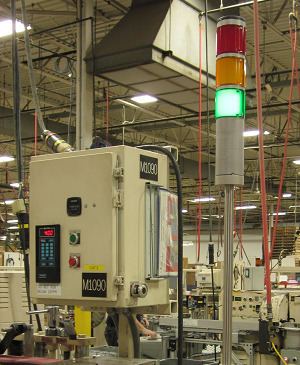 | ||
Stack lights (aka: signal tower lights, indicator lights, AndOn lights, warning lights, industrial signal lights, tower lights and light towers) are commonly used on equipment in industrial manufacturing and process control environments to provide visual and audible indicators of a machine state or process event to machine operators, technicians, production managers and factory personnel.
Contents
General
Stack lights are used in similar applications as beacon lights/strobes, however the information they typically display encompasses more machine/process conditions. Stack lights typically use incandescent, LED or xenon-type strobes as their illumination source.
Stack lights are generally columnar structures in a variety of shapes, placing colour-coded indicator segments on top of one another in a "stacked" orientation. A stack light will typically have up to 5 differently coloured segments to indicate various conditions on the machine or process.
Segments in any combination of (typically) red, yellow, green, blue or clear white are actuated independently and are either off, solid-on (continuous) or flashing.
Stack lights are passive devices that may be controlled directly by programmable logic controllers, distributed control systems, PC control systems or hardwired to machine controls such as timers, sensors and latching relays.
Discrete signals activate illuminated segments at common industrial control voltages (including 12Vdc, 24Vac/dc, 115Vac, 230Vac). Some units support fieldbus networked control through popular industrial networks such as Modbus, DeviceNet, Profibus, CAN-Open or ASi.
Flashing control may be provided by the stack light's internal circuitry or externally controlled with timers or logic controllers.
Stack lights are available for all types of industrial environments including washdown (IP65) and explosion proof.
Function
Stack lights are used in a variety of machines and process environments; specific colour-coding is assigned by the system designer.
Commonly used colour codes for machine state conditions include:
IEC60073 addresses machine state colour-coding & acoustic alerting, which can be applied to devices including panel pilot lights & stack lights. Machine operator intervention is typically required in red and yellow machine states, as these are normally errors or warnings. Manual intervention is possibly necessary in blue and white conditions.
Applications
Common applications include, but are not limited to:
